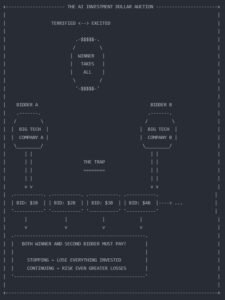Just read a fascinating interview with Marco Trombetti (CEO of Translated) that perfectly illustrates the economic trap we’re falling into with AI investment – one that might be entirely by design.
Trombetti describes the current AI landscape with a telling phrase: “Gli investitori sono terrorizzati… e esaltati” (Investors are terrified… and excited). Why? Because they’ve found themselves caught in what economists call a “dollar auction” – one of the most elegant demonstrations of how rational individual decisions lead to collective irrationality.
What is the Dollar Auction?
The dollar auction is a famous economic experiment where participants bid on a $1 bill with one crucial twist: both the winner AND the second-place bidder must pay their bids. Only the winner gets the dollar.
This creates a fascinating trap. Once you’ve bid 90¢, you’re incentivized to bid $1 to win rather than lose 90¢ for nothing. But then your opponent, facing the same logic, bids $1.10. Now
you’re facing losing 90¢ or bidding $1.20 to “cut your losses.” The bidding often escalates well beyond $1, with both parties losing money but continuing to bid to avoid being the second-place loser.

How This Explains Today’s AI Investment Landscape
Trombetti perfectly captures how AI has become a dollar auction:
- Massive capital requirements: “Oggi per entrare in questa corsa servono miliardi” (Today you need billions to enter this race)
- Winner-takes-all dynamics: “L’Ai è una tecnologia che quando avanza di livello non ammette numeri due o numeri tre” (AI is a technology that, when it advances a level, doesn’t allow for second or third place)
- Constant obsolescence trap: Training costs have shifted from capital expenditures to operational ones, meaning companies must continuously reinvest or face irrelevance
- The fear of becoming the second-highest bidder: Companies continue investing beyond rational economic returns because stopping means losing everything they’ve already invested
The Inevitable Waste
The most concerning aspect is that this structure guarantees massive economic waste. As Trombetti notes, these companies are using “pochissima differenza tra di loro” (very little difference between them) in their approaches – essentially duplicating efforts at enormous scale while most are destined to fail.
This isn’t just academic – we’re witnessing potentially trillions in capital allocation being driven by competitive dynamics rather than underlying value creation.
The Narrative We Should Question
Here’s what’s increasingly clear: the “winner-takes-all” framing isn’t an inevitable truth about AI – it’s a narrative that primarily benefits established US tech giants and their investors. By creating an artificial sense of existential competition, they’ve manufactured precisely the conditions that make the dollar auction trap work.
Alternative models exist. We could structure AI development as a collaborative ecosystem of specialized models, for example.
The dollar auction only works when participants accept its premise. Perhaps the problem for European AI isn’t Europe’s regulatory caution, but accepting the false premise that AI must be a winner-takes-all game.

